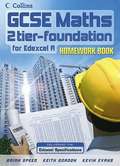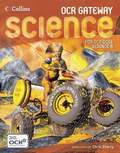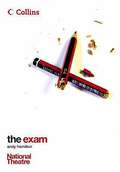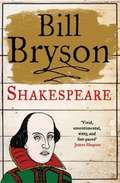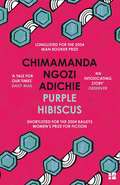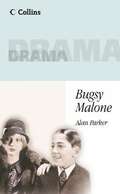- Table View
- List View
GCSE Maths 2 tier-foundation for Edexcel A - Homework Book (PDF)
by Brian Speed Keith Evans Keith GordonThis Homework books accompanies the GCSE Maths scheme for Edexcel Linear (A) - Foundation. It contains thousands of homework questions to support topics covered in the Collins GCSE Maths Student Books.
GCSE Maths 2 Tier-Foundation for Edexcel A: Student Book (PDF)
by Brian Speed Keith Evans Keith GordonCollins GCSE Maths for Edexcel is the easiest way to teach 2-tier Mathematics. This acclaimed series guarantees total coverage of the new Edexcel (A) GCSE Maths Specification. The series provides a stimulating approach to Maths that really appeals to students.
GCSE Science for AQA - Science Student Book (PDF)
by Edmund Walsh Emma Poole Louise Petheram Leslie Owen Charles Golabek Aleks Jedrosz Mary JonesThis book will provide you with complete coverage of the new AQA GCSE Science specification.
OCR Gateway Science for OCR GCSE Science B: student book (PDF)
by Dave Berrington Edmund Walsh Louise Smiles Chris Sherry Phil Hils Colin Bell Ann DanielsPart of Collins' OCR Gateway series for GCSE Sciences, this student textbook provides material to teach and prepare students for GCSE Science. It has been written by examiners in consultation with OCR.
Collins National Theatre Plays - The Exam (PDF)
by Andy HamiltonThe Exam is a funny but serious look at the pressures faced by pupils today, both at school and at home. The play is accompanied by teaching materials containing fantastic ideas for drama work, as well as other activities designed to answer English Framework and NC objectives.The exam is comic look at the pressures put on young people by parents and teachers.
Shakespeare: The World as a Stage (PDF)
by Bill BrysonIn this much anticipated addition to the Eminent Lives series, Bill Bryson's biography of William Shakespeare unravels the superstitions, academic discoveries and myths surrounding the life of our greatest poet and playwright. Shakespeare's life, despite the scrutiny of generations of biographers and scholars, is still a thicket of myths and traditions, some preposterous, some conflicting, arranged around the few scant facts known about the Bard - from his birth in Stratford to the bequest of his second best bed to his wife when he died. Following his international bestsellers A Short History of Nearly Everything' and The Life and Times of the Thunderbolt Kid', Bill Bryson has written a short biography of William Shakespeare for the Eminent Lives series - which seeks to pair great subjects with writers known for their strong sensibilities and sharp, lively points of view.
Purple Hibiscus (PDF)
by Chimamanda Ngozi AdichieThe limits of fifteen-year-old Kambili's world are defined by the high walls of her family estate and the dictates of her fanatically religious fath. Her life is regulated by schedules: prayer, sleep, study, prayer. When Nigeria is shaken by a military coup, Kambili's father, involved mysteriously in the political crisis, sends her to live with her aunt. In this house, noisy and full of laughter, she discovers life and love - and a terrible, bruising secret deep within her family. This extraordinary debut novel from Chimamanda Ngozi Adichie, author of 'Half of a Yellow Sun', is about the blurred lines between the old gods and the new, childhood and adulthood, love and hatred - the grey spaces in which truths are revealed and real life is lived.
Purple Hibiscus
by Chimamanda Ngozi AdichieThe limits of fifteen-year-old Kambili's world are defined by the high walls of her family estate and the dictates of her fanatically religious fath. Her life is regulated by schedules: prayer, sleep, study, prayer. When Nigeria is shaken by a military coup, Kambili's father, involved mysteriously in the political crisis, sends her to live with her aunt. In this house, noisy and full of laughter, she discovers life and love - and a terrible, bruising secret deep within her family. This extraordinary debut novel from Chimamanda Ngozi Adichie, author of 'Half of a Yellow Sun', is about the blurred lines between the old gods and the new, childhood and adulthood, love and hatred - the grey spaces in which truths are revealed and real life is lived.
Reaction vessels (UEB Contracted)
by Rnib BookshareThis page shows twelve laboratory reaction vessels seen from the side in cross section. There is a locator dot and title shown, which will be at the top left of the page when it is the correct way up. The vessels are usually made from clear borosilicate heat-resistant glass. There are five vessels shown in a row at top of the page and seven on the bottom of the page. Each image is labelled down the page.
Reaction vessels (Large Print)
by Rnib BookshareThis page shows twelve laboratory reaction vessels seen from the side in cross section. There is a locator dot and title shown, which will be at the top left of the page when it is the correct way up. The vessels are usually made from clear borosilicate heat-resistant glass. There are five vessels shown in a row at top of the page and seven on the bottom of the page. Each image is labelled down the page.
Element, Compound and Mixture (Diagram PDF)
by Katie WalkerI have created this resource for a year 7 student with Achromatopsia. This diagram enables the student to identify the difference between an element (1 type of atom), a compound (more than 1 atom chemically bonded) and a mixture (more than one substance). I hope this helps with resource helps.
Miscellaneous laboratory equipment 2 (UEB Uncontracted)
by Rnib BookshareThis page shows items of laboratory equipment seen from the side in cross section. There is a locator dot and title shown, which will be at the top left of the page when it is the correct way up. There are three items at the top of the page and three at the bottom. In the lower part of the desiccator, in the top left of the page, there are crystals of silica gel desiccant. The bell jar, in the top right of the page, stands on a sheet of plate glass and has a beaker standing inside it.
Meiosis phase two (UEB Contracted)
by Rnib BookshareThese pages show the four stages of the second phase of meiosis and non-identical gametes as a product of meiosis. There is a locator dot shown on each page, which will be at the top left of the page when the image is the correct way up. Meiosis is cell replication where a cell divides to produce four non-identical gametes, each with only one set of chromosomes instead of the usual two sets found in all other cells.Meiosis - stage five, prophase II. This page shows the start of the second phase of meiosis. The original cell has divided into two non-identical cells. There is a cell to the left and right of the page. The cell to the left has a pair of centrioles in the bottom and a single chromatid in the top of the cell. The cell to the right has a pair of centrioles in the top and a single chromatid in the bottom of the cell. In reality in humans there would be twenty three chromatids in each cell.Meiosis - stage six, metaphase II. This page shows a cell to the left and right. Each has a completed mitotic spindle with a centriole to the top and bottom. The chromatids have attached themselves to the centre of each spindle on the central microtubule by their centromeres in the centre of each cell. For clarity other chromatids are not shown so the microtubule to the left and right of each cell appears empty. In reality there would be many more chromatids and microtubules.Meiosis - stage seven, anaphase II. This page shows the centromeres have separated in each cell to the left and right of the page. The microtubules of the spindle are retracting to the top and bottom. The chromatids have split, and each chromosome of each chromatid are migrating to opposite ends of the spindle to the top and bottom in each cell.Meiosis - stage eight, telophase II. This page shows two cells with centrioles to the top and bottom. There is a single chromosome to the top and bottom centre of each cell. The plasma membrane is pinching in from the left and right and starting to divide the cytoplasm in each cell. Four non-identical gametes produced The cells have divided to form four genetically non-identical cells. Each has only one of the original pair of chromosomes. In reality each gamete would have one set of twenty three chromosomes, only one is shown for clarity.
Miscellaneous laboratory equipment 2 (UEB Contracted)
by Rnib BookshareThis page shows items of laboratory equipment seen from the side in cross section. There is a locator dot and title shown, which will be at the top left of the page when it is the correct way up. There are three items at the top of the page and three at the bottom. In the lower part of the desiccator, in the top left of the page, there are crystals of silica gel desiccant. The bell jar, in the top right of the page, stands on a sheet of plate glass and has a beaker standing inside it.
Meiosis phase two (UEB Uncontracted)
by Rnib BookshareThese pages show the four stages of the second phase of meiosis and non-identical gametes as a product of meiosis. There is a locator dot shown on each page, which will be at the top left of the page when the image is the correct way up. Meiosis is cell replication where a cell divides to produce four non-identical gametes, each with only one set of chromosomes instead of the usual two sets found in all other cells.Meiosis - stage five, prophase II. This page shows the start of the second phase of meiosis. The original cell has divided into two non-identical cells. There is a cell to the left and right of the page. The cell to the left has a pair of centrioles in the bottom and a single chromatid in the top of the cell. The cell to the right has a pair of centrioles in the top and a single chromatid in the bottom of the cell. In reality in humans there would be twenty three chromatids in each cell.Meiosis - stage six, metaphase II. This page shows a cell to the left and right. Each has a completed mitotic spindle with a centriole to the top and bottom. The chromatids have attached themselves to the centre of each spindle on the central microtubule by their centromeres in the centre of each cell. For clarity other chromatids are not shown so the microtubule to the left and right of each cell appears empty. In reality there would be many more chromatids and microtubules.Meiosis - stage seven, anaphase II. This page shows the centromeres have separated in each cell to the left and right of the page. The microtubules of the spindle are retracting to the top and bottom. The chromatids have split, and each chromosome of each chromatid are migrating to opposite ends of the spindle to the top and bottom in each cell.Meiosis - stage eight, telophase II. This page shows two cells with centrioles to the top and bottom. There is a single chromosome to the top and bottom centre of each cell. The plasma membrane is pinching in from the left and right and starting to divide the cytoplasm in each cell. Four non-identical gametes produced The cells have divided to form four genetically non-identical cells. Each has only one of the original pair of chromosomes. In reality each gamete would have one set of twenty three chromosomes, only one is shown for clarity.
Miscellaneous laboratory equipment 2 (Large Print)
by Rnib BookshareThis page shows items of laboratory equipment seen from the side in cross section. There is a locator dot and title shown, which will be at the top left of the page when it is the correct way up. There are three items at the top of the page and three at the bottom. In the lower part of the desiccator, in the top left of the page, there are crystals of silica gel desiccant. The bell jar, in the top right of the page, stands on a sheet of plate glass and has a beaker standing inside it.
Meiosis phase two (Large Print)
by Rnib BookshareThese pages show the four stages of the second phase of meiosis and non-identical gametes as a product of meiosis. There is a locator dot shown on each page, which will be at the top left of the page when the image is the correct way up. Meiosis is cell replication where a cell divides to produce four non-identical gametes, each with only one set of chromosomes instead of the usual two sets found in all other cells.Meiosis - stage five, prophase II. This page shows the start of the second phase of meiosis. The original cell has divided into two non-identical cells. There is a cell to the left and right of the page. The cell to the left has a pair of centrioles in the bottom and a single chromatid in the top of the cell. The cell to the right has a pair of centrioles in the top and a single chromatid in the bottom of the cell. In reality in humans there would be twenty three chromatids in each cell.Meiosis - stage six, metaphase II. This page shows a cell to the left and right. Each has a completed mitotic spindle with a centriole to the top and bottom. The chromatids have attached themselves to the centre of each spindle on the central microtubule by their centromeres in the centre of each cell. For clarity other chromatids are not shown so the microtubule to the left and right of each cell appears empty. In reality there would be many more chromatids and microtubules.Meiosis - stage seven, anaphase II. This page shows the centromeres have separated in each cell to the left and right of the page. The microtubules of the spindle are retracting to the top and bottom. The chromatids have split, and each chromosome of each chromatid are migrating to opposite ends of the spindle to the top and bottom in each cell.Meiosis - stage eight, telophase II. This page shows two cells with centrioles to the top and bottom. There is a single chromosome to the top and bottom centre of each cell. The plasma membrane is pinching in from the left and right and starting to divide the cytoplasm in each cell. Four non-identical gametes produced The cells have divided to form four genetically non-identical cells. Each has only one of the original pair of chromosomes. In reality each gamete would have one set of twenty three chromosomes, only one is shown for clarity.
Miscellaneous laboratory equipment 1 (UEB Uncontracted)
by Rnib BookshareThis page shows eight items of laboratory equipment. All are seen from the side in cross section, except the micro-chambered test slide in the top left corner of the page, which is viewed from the top. There is a locator dot and title shown, which will be at the top left of the page when it is the correct way up. The items are arranged in three columns with each item labelled down the page.
Meiosis Phase One (UEB Uncontracted)
by RnibThese pages show late interphase before meiosis, and five stages of meiosis phase one. There is a locator dot shown on each page, which will be at the top left of the page when the image is the correct way up. Meiosis is cell replication where a cell divides to produce four non-identical gametes, each with only one set of chromosomes instead of the usual two sets found in all other cells.Late interphase before meiosis. This page shows a cell immediately before meiosis starts. The cell is a large rounded shape in the centre of the page. Its nucleus fills the bottom of the cell and two centrioles are in the top of the cell. The twenty three pairs of chromosomes in the nucleus have replicated to form a mass of chromatids (double chromosomes) which are tightly coiled. Note the size of the nucleus and the centrioles in relation to the overall size of the cell are greatly enlarged for clarity. Only some of the chromatin is shown, also for clarity. Meiosis - stage one, early prophase I. This page shows the start of meiosis. The cell is in the centre of the page. In the top of the cell the centrioles to the left and right have the mitotic spindle growing between them. The nucleus shows two chromatids - the double chromosomes. The ends of the chromosomes of the chromatids are crossed in two places, to the top and bottom of the pair. In reality in humans there would be twenty three pairs of chromatids.Meiosis - stage one, late prophase I. This page shows chromatids after crossover. The cell is in the centre of the page. In the top of the cell the centrioles to the left and right have the mitotic spindle growing between them. The nucleus shows two chromatids - the double chromosomes. The ends of the chromosomes of the chromatids have swapped DNA coding where they were crossed. The ends to the top centre of the chromatids have swapped and the ends of the other pair of chromosomes to the bottom centre have also swapped.Meiosis - stage two, metaphase I. This page shows the completed mitotic spindle with a centriole to the left and right. The nuclear envelope has disappeared. The chromatids have attached themselves side by side to the centre of the spindle on the central microtubule by their centromeres in the centre of the image. For clarity other chromatids are not shown so the microtubule to the top and bottom of the image appears empty. In reality there would be many more pairs of chromatids and microtubules.Meiosis - stage three, anaphase I. This page shows the centromeres have separated. The microtubules of the spindle are retracting to the left and right. Each chromatid of the pair of chromosomes are migrating to opposite ends of the spindle to the left and right.Meiosis - stage four, telophase I. This page shows centrioles to the left and to the right. One chromatid is in the left and one chromatid is in the right of the cell. To the top and bottom centre of the cell the plasma membrane is pinching in and starting to divide the cytoplasm.
Miscellaneous Laboratory Equipment 1 (UEB Contracted)
by RnibThis page shows eight items of laboratory equipment. All are seen from the side in cross section, except the micro-chambered test slide in the top left corner of the page, which is viewed from the top. There is a locator dot and title shown, which will be at the top left of the page when it is the correct way up. The items are arranged in three columns with each item labelled down the page.
Meiosis phase one (UEB Uncontracted)
by Rnib BookshareThese pages show late interphase before meiosis, and five stages of meiosis phase one. There is a locator dot shown on each page, which will be at the top left of the page when the image is the correct way up. Meiosis is cell replication where a cell divides to produce four non-identical gametes, each with only one set of chromosomes instead of the usual two sets found in all other cells.Late interphase before meiosis. This page shows a cell immediately before meiosis starts. The cell is a large rounded shape in the centre of the page. Its nucleus fills the bottom of the cell and two centrioles are in the top of the cell. The twenty three pairs of chromosomes in the nucleus have replicated to form a mass of chromatids (double chromosomes) which are tightly coiled. Note the size of the nucleus and the centrioles in relation to the overall size of the cell are greatly enlarged for clarity. Only some of the chromatin is shown, also for clarity. Meiosis - stage one, early prophase I. This page shows the start of meiosis. The cell is in the centre of the page. In the top of the cell the centrioles to the left and right have the mitotic spindle growing between them. The nucleus shows two chromatids - the double chromosomes. The ends of the chromosomes of the chromatids are crossed in two places, to the top and bottom of the pair. In reality in humans there would be twenty three pairs of chromatids.Meiosis - stage one, late prophase I. This page shows chromatids after crossover. The cell is in the centre of the page. In the top of the cell the centrioles to the left and right have the mitotic spindle growing between them. The nucleus shows two chromatids - the double chromosomes. The ends of the chromosomes of the chromatids have swapped DNA coding where they were crossed. The ends to the top centre of the chromatids have swapped and the ends of the other pair of chromosomes to the bottom centre have also swapped.Meiosis - stage two, metaphase I. This page shows the completed mitotic spindle with a centriole to the left and right. The nuclear envelope has disappeared. The chromatids have attached themselves side by side to the centre of the spindle on the central microtubule by their centromeres in the centre of the image. For clarity other chromatids are not shown so the microtubule to the top and bottom of the image appears empty. In reality there would be many more pairs of chromatids and microtubules.Meiosis - stage three, anaphase I. This page shows the centromeres have separated. The microtubules of the spindle are retracting to the left and right. Each chromatid of the pair of chromosomes are migrating to opposite ends of the spindle to the left and right.Meiosis - stage four, telophase I. This page shows centrioles to the left and to the right. One chromatid is in the left and one chromatid is in the right of the cell. To the top and bottom centre of the cell the plasma membrane is pinching in and starting to divide the cytoplasm.
Miscellaneous laboratory equipment 1 (Large Print)
by RnibThis page shows eight items of laboratory equipment. All are seen from the side in cross section, except the micro-chambered test slide in the top left corner of the page, which is viewed from the top. There is a locator dot and title shown, which will be at the top left of the page when it is the correct way up. The items are arranged in three columns with each item labelled down the page.
Mitosis (UEB Contracted)
by Rnib BookshareThese pages show interphase before mitosis, four stages of mitosis and daughter cells as a product of mitosis. There is a locator dot shown on each page, which will be at the top left of the page when the image is the correct way up. Mitosis is cell replication where a cell divides to produce two identical daughter cells. Late interphase - This page shows a cell immediately before mitosis starts. The cell is a large rounded shape in the centre of the page. Its nucleus fills the bottom of the cell and two centrioles are in the top of the cell. The twenty three pairs of chromosomes in the nucleus have replicated to form a mass of chromatids (double chromosomes) which are tightly coiled. Note the size of the nucleus and the centrioles in relation to the overall size of the cell are greatly enlarged for clarity. Only some of the chromatin is shown, also for clarity. Mitosis - stage one, Prophas - This page shows the start of mitosis. The cell is in the centre of the page. In the top of the cell the centrioles to the left and right have the mitotic spindle growing between them. The nucleus shows three chromatids, the double chromosomes. In reality in humans there would be twenty three chromatids. Mitosis - stage two, Metaphase - This page shows the completed mitotic spindle with a centriole to the left and right. The nuclear envelope has disappeared. The chromatids have attached themselves to the centre of the spindle by their centromeres in the centre of the image. Mitosis - stage three, Anaphase - This page shows the centromeres have separated. The microtubules of the spindle are retracting to the left and right. Each chromatid has split into single sister chromosomes and are migrating to opposite ends of the spindle to the left and right. Mitosis - stage four, Telophase - This page shows the spindle to left and to the right, nearly gone. The chromosomes have collected together and a new nuclear envelope has formed around them. To the top and bottom centre of the cell the plasma membrane is pinching in and starting to divide the cytoplasm. Identical daughter cells The cell has divided to form two genetically identical cells. Each has a nucleus to the left centre of the cell.
Mitosis (Large Print)
by Rnib BookshareThis image shows the four stages of mitosis over two pages. Page One has two images: 1. A cell has 4 chromosomes, two pairs. 2. Chromosomes are copied. Page Two has two images: 3. Chromosomes form one line down the centre of the cell. 4. One copy of each chromosome moves to the opposite pole of the cell.
